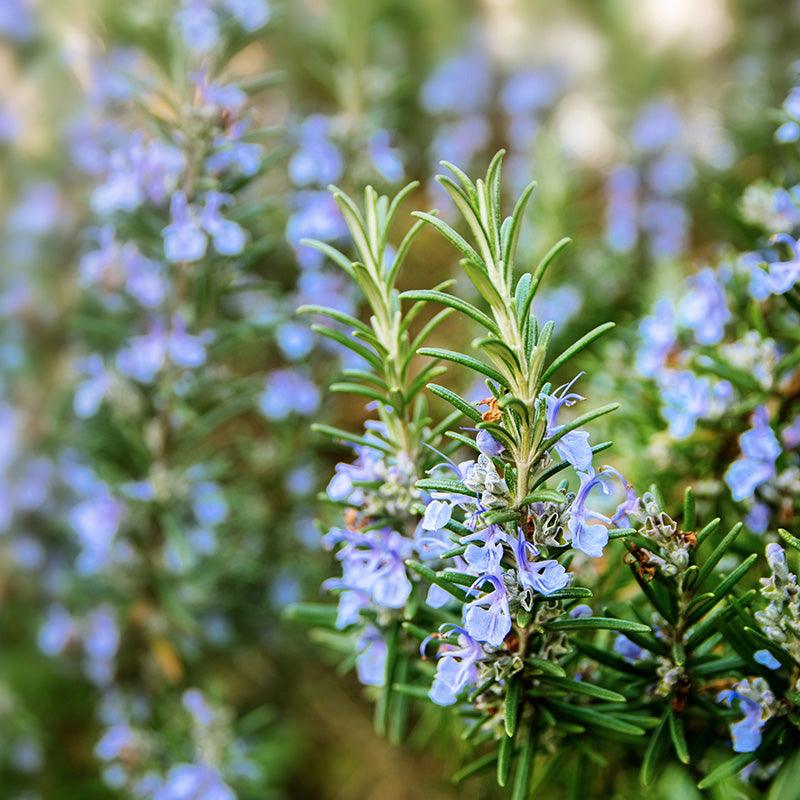Item Number: PV162
Organic Rosemary
Culinary Essential: Spiky, Aromatic Rosemary
Rosemary serves as an attractive ornamental shrub, featuring spiky, grayish needle-like foliage, lovely lavender-blue flowers, and a slender upright structure. Highly valued by chefs, its needle-shaped leaves enhance the flavors of savory breads, herbal butters, vegetables, and roasted meats. In addition to their culinary use, the delicate bluish-purple flowers, blooming in mid-summer, serve as both a beautiful floral accent and an edible garnish. The aromatic leaves can be enjoyed fresh or dried throughout the year.
Sustainably grown in 2.75" pots
Selecting the Right Location
Rosemary thrives in full sunlight, so choose a location in your garden that receives at least 6-8 hours of sunlight per day. Ensure that the soil is well-draining, as rosemary does not tolerate waterlogged conditions. Sandy or loamy soil with good drainage is ideal. Consider planting rosemary in containers or raised beds if you have heavy or clayey soil.
Planting Rosemary
Spring or early summer is the best time to plant rosemary, once the threat of frost has passed. Dig a hole slightly larger than the root ball of the rosemary plant and place it in the hole at the same depth as it was in the container. Space multiple rosemary plants at least 2-3 feet apart to allow for adequate airflow and growth.
Watering and Soil Care
Water newly planted rosemary regularly to establish a strong root system. Once established, rosemary is drought-tolerant and only requires occasional watering. Avoid overwatering, as this can lead to root rot. Allow the soil to dry out slightly between waterings. Mulch around the base of the plants to help retain moisture and suppress weeds.
Fertilizing
Rosemary is not a heavy feeder and generally thrives in nutrient-poor soil. Avoid using high-nitrogen fertilizers, as they can promote excessive leaf growth at the expense of flavor. A light application of balanced fertilizer in spring can help promote healthy growth, but be cautious not to over-fertilize.
Pruning and Maintenance
Regular pruning helps maintain the shape and vigor of rosemary plants. Prune lightly throughout the growing season to encourage bushy growth. Remove any dead or woody stems to improve airflow and reduce the risk of disease. Harvesting rosemary leaves regularly also serves as a form of pruning and helps promote new growth.
Pests and Diseases:
Rosemary is relatively resistant to pests and diseases, but it can occasionally be affected by spider mites, aphids, or powdery mildew. Keep an eye out for signs of pest infestation or disease and take appropriate measures, such as using insecticidal soap or neem oil, to control them if necessary.
Harvesting and Using Rosemary:
You can start harvesting rosemary leaves once the plant reaches about 6-8 inches in height. Simply snip off the desired amount of leaves using sharp scissors or pruning shears. Rosemary leaves can be used fresh or dried for culinary purposes, adding flavor to a wide range of dishes such as roasted meats, soups, stews, and marinades. To dry rosemary, hang bunches of stems upside down in a well-ventilated area away from direct sunlight until they are fully dried. Once dry, store the leaves in an airtight container for future use.
Growing rosemary is a rewarding endeavor that can provide you with an abundant supply of this versatile herb for culinary, medicinal, and decorative purposes. By following the guidelines outlined in this guide, you can successfully cultivate healthy and vibrant rosemary plants in your garden or landscape.




Check Your Zone Compatibility:
Compatible with your zone.
Growing Zone for

Our Guarantee To You
Since 1976, we've served our customers at every stage of growing. Please contact us at any time. We are happy to support and assist you.
Shipping Information
Shipping Information
Cannot ship to the following states: AK, HI, PR, VI, GU
Shipping Weight: 0.5 lb
Features
Features
- Attracts Bees/Butterflies
- Container Compatible
- Does Not Require Support
- Drought Tolerant
- Edible Flower
- Fragrant
- Good for Drying
- Heat Tolerant
- Open-Pollinated
- Useful for Ornamental
Characteristics
Characteristics
Planting & Care
Planting & Care
Soil and Water: Very drought tolerant once established, water regularly the first year then be careful not to over water. Rosemary thrives in various soil types.
Planting and Growing: Plants thrive in hot dry conditions and prefer well drained soil. Rosemary is slow growing the first year.
Harvesting and Storage: Harvest whole stems to flavor meats and soups or crush leaves with root vegetables, breads and many other culinary uses.
Useful Information
Useful Information
Guarantee
Guarantee
We guarantee the perishable items we sell to be in good, viable condition when we sell them. Perishable items include, but are not limited to, garlic bulbs, flower bulbs, seed potatoes, onion sets & transplants, potted or bare root trees, vegetable crowns, etc. If your perishable item arrives in substandard condition, take photographs and please contact us within 3 days of the purchase date (or delivery date) and we will provide you with a refund of the purchase price (excluding shipping costs), or a replacement. Accordingly, we urge you to open any boxes marked as ""Perishable"" immediately upon receiving them and inspect the shipment thoroughly (do not crack open heads of garlic, we do not accept claims on cracked garlic). Because some perishable items can deteriorate very quickly, we cannot accept any claims beyond the 3-day time frame as it becomes too difficult to determine if these items were delivered in substandard condition, or if they turned into such substandard condition because of having been improperly cared for or stored once delivered.
Share


